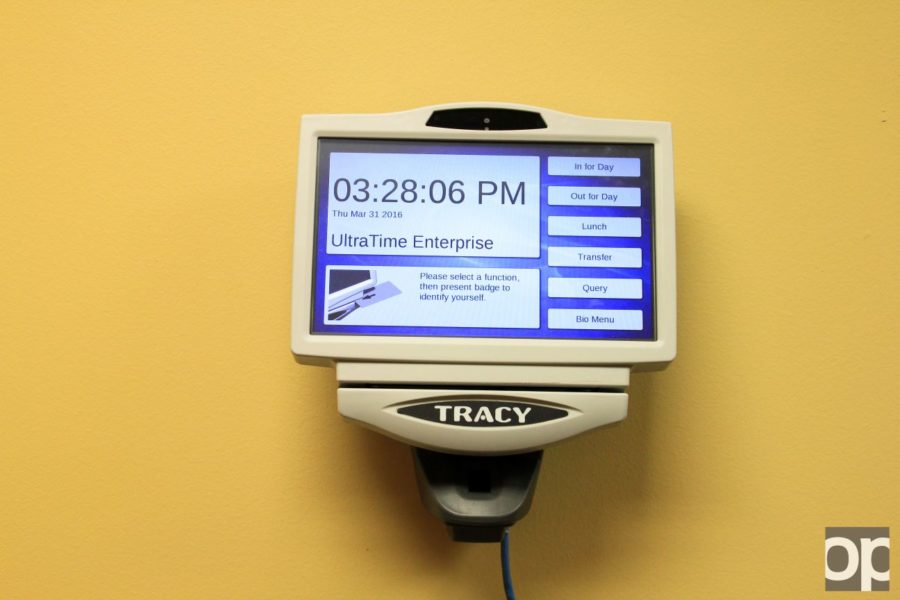Maximum hours for student-employees cut to 20 per week
The Student Technology Center has one of the 38 Tracy UltraTime Enterprise machines around campus which lets student-employees check-in and check-out with their ID and fingerprint.
Beginning next fall, Oakland University’s on-campus student employees will be able to work a maximum of 20 hours per week, a five-hour cutback from the current 25-hour limit.
Along with this change comes a university-wide implementation of time clocks for student employees.
Under the Affordable Care Act, employees working an average of 30 hours per week are considered full-time and therefore qualify for health care benefits. Although student employees working the current maximum of 25 hours don’t meet this criteria, working 1,560 hours per year equates to an average of 30 hours per week.
Under the ACA, a student working the 25 hours during the fall and winter semesters and 40 hours during the summer would cumulatively be working enough hours to qualify for health care.
According to Oakland University Payroll Manager George Leaver, universities wishing to avoid paying ACA-mandated health care are basically split into two camps: those who allow students to work less than 30 hours per week year round, and those who allow students to work less hours during the fall and winter semester, but more hours during the summer.
For example, students at Western Michigan University are allowed to work on-campus for up to 25 hours per week, while students at Michigan State University are capped at 29 year round.
A task force made up of representatives from OU’s four hiring departments decided that OU will join the second camp, alongside Wayne State University, University of Detroit-Mercy and Lawrence Technological University, which all employ a 20-hour weekly maximum for on-campus student-employees during the during the fall and winter semesters.
“There’s been conversation back and forth over the years over whether 20 or 25 hours is appropriate for the students, and the Affordable Care Act actually forced us to relook at things,” Leaver said.
“Our effort in this task force was to understand the law because it kept changing,” he added.
This decision was based heavily on the fact that less than 100 of OU’s 2,300 student-employees currently exceed 20 hours per week during the fall and winter, while an average of about 158 students work the maximum 40 hours in the summer.
But, the new policy does remove potential hours from students who don’t work on campus during the summer, and therefore would not qualify for health care even if the 25-hour maximum remained.
“We actually found that a third of the students that are going over the limit are working more than one job on-campus,” Cindy Hermsen, director of financial aid, said. “So, some of the thought is that by going over the 20, that’s denying other students the opportunity to work on-campus.”
Although Hermsen noted that there have been recent increases in minimum wage, individual departments are not required to adjust students’ wages accordingly. Hermsen added that announcing the changes this far in advance gives students time to make additional employment arrangements if needed.
She said one option for students who will be negatively affected by this change is to find an off-campus job, and according to Hermsen, hours worked on-campus for third-party employers, like Chartwells or Barnes and Noble, will not count toward the 20-hour maximum.
“What is troubling is that we [students] weren’t really included in the decision-making process,” said new OUSC President Zack Thomas. “No one in student congress was involved, no one was reached out to about it.”
The university announced a similar cut in August 2014, but later retracted it because some leeway was found within the boundaries of the law. However, new changes effective in June bring the threat of a $2,000 fee for every employee who should be offered benefits, but isn’t. This puts pressure on employers to enforce the ACA’s limits.
“We’re definitely on top of monitoring changes. The political landscape is questionable . . . It could be a completely different conversation this time next year, but for now, these are the ground rules and we’re trying to work under them,” Leaver said.
New time clock system
A new university-wide time clock system will keep employees and supervisors accountable for hours worked. Implementation began in October 2014, and Leaver hopes to see the entire university converted by the beginning of next fall.
There are currently 38 Tracy UltraTime machines up and running, on which employees punch in and out using a touch screen menu and their ID cards. There will eventually be 52 machines installed throughout campus and all part-time employees will be required to use the system.
Each machine costs $1,700 plus installation fees.
Approximately 800 employees are already using the system, including workers in the Campus Recreation Center, the Student Technology Center and Housing. Leaver said the system has received positive feedback.
“Once you train the students how to swipe the card and push the button, there’s a lot less work for the supervisor,” Leaver said.






